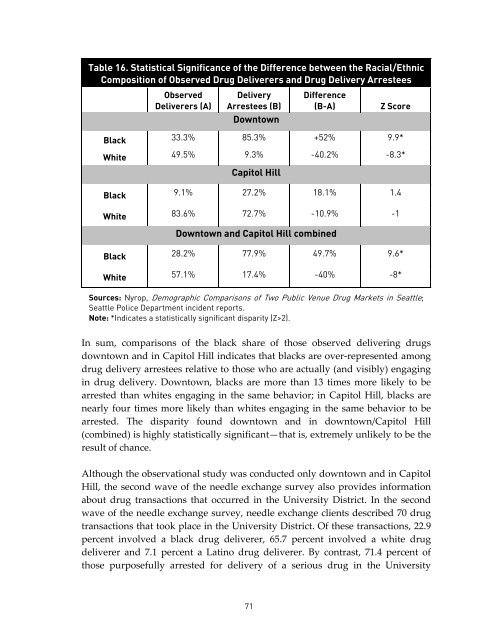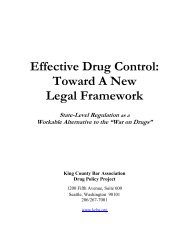RACE AND THE ENFORCEMENT OF DRUG DELIVERY LAWS IN ...
RACE AND THE ENFORCEMENT OF DRUG DELIVERY LAWS IN ...
RACE AND THE ENFORCEMENT OF DRUG DELIVERY LAWS IN ...
You also want an ePaper? Increase the reach of your titles
YUMPU automatically turns print PDFs into web optimized ePapers that Google loves.
Table 16. Statistical Significance of the Difference between the Racial/Ethnic<br />
Composition of Observed Drug Deliverers and Drug Delivery Arrestees<br />
Observed<br />
Deliverers (A)<br />
Delivery<br />
Arrestees (B)<br />
Downtown<br />
Difference<br />
(B-A)<br />
Z Score<br />
Black 33.3% 85.3% +52% 9.9*<br />
White 49.5% 9.3% -40.2% -8.3*<br />
Capitol Hill<br />
Black 9.1% 27.2% 18.1% 1.4<br />
White 83.6% 72.7% -10.9% -1<br />
Downtown and Capitol Hill combined<br />
Black 28.2% 77.9% 49.7% 9.6*<br />
White 57.1% 17.4% -40% -8*<br />
Sources: Nyrop, Demographic Comparisons of Two Public Venue Drug Markets in Seattle;<br />
Seattle Police Department incident reports.<br />
Note: *Indicates a statistically significant disparity (Z>2).<br />
In sum, comparisons of the black share of those observed delivering drugs<br />
downtown and in Capitol Hill indicates that blacks are over-represented among<br />
drug delivery arrestees relative to those who are actually (and visibly) engaging<br />
in drug delivery. Downtown, blacks are more than 13 times more likely to be<br />
arrested than whites engaging in the same behavior; in Capitol Hill, blacks are<br />
nearly four times more likely than whites engaging in the same behavior to be<br />
arrested. The disparity found downtown and in downtown/Capitol Hill<br />
(combined) is highly statistically significant—that is, extremely unlikely to be the<br />
result of chance.<br />
Although the observational study was conducted only downtown and in Capitol<br />
Hill, the second wave of the needle exchange survey also provides information<br />
about drug transactions that occurred in the University District. In the second<br />
wave of the needle exchange survey, needle exchange clients described 70 drug<br />
transactions that took place in the University District. Of these transactions, 22.9<br />
percent involved a black drug deliverer, 65.7 percent involved a white drug<br />
deliverer and 7.1 percent a Latino drug deliverer. By contrast, 71.4 percent of<br />
those purposefully arrested for delivery of a serious drug in the University<br />
71

















